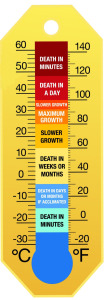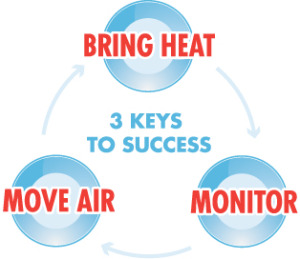
Heat Treatment for Bed Bugs
Heat Treatments
Most bed bug treatments are extremely tedious, require multiple visits, a significant amount of preparation, and use of insecticides to control the situation. As time goes on, bed bugs are growing increasingly resistant to known methods of extermination.. There are also a dwindling amount of treatment alternatives due to increased regulation on chemical options. However, with the use of heat, a bed bug infestation can be eliminated in a shorter period of time without the use of chemicals. This allows business to resume normal use of the treated space more quickly.
Why Heat Versus Insecticides?
Bed bugs are one of the hardest insects to control in the industry today. They are showing resistance (immunity) to almost all of the most common types of insecticides used by the pest control industry. There are various references throughout the internet pertaining to parathyroid insecticide resistance of bed bugs. Even with rotation of various types of insecticides control is extremely hard to achieve. An informal survey of pest control operators conducted by an entomologist at the University of Massachusetts found that 68% of all bedbug infestations require three or more treatments, 26% require two treatments, and 6% require just one. Preparation is also another factor when treating for bed bugs, when treating for bed bugs with insecticides the property being treated needs to completely prepared which can take an average of 4 hours for a standard apartment, and a day for a  small house. Heat treatment in contrast needs less preparation as the property is completely heated along with all the belongings inside the property.
small house. Heat treatment in contrast needs less preparation as the property is completely heated along with all the belongings inside the property.
Thermal Remediation
Thermal Remediation: Thermal remediation uses heat to kill all life  cycles of bed bugs. Target temperature during treatment is between 120-135°F, the temperature necessary for heat to penetrate bed bug living areas. This safe, effective, and environmentally friendly process uses dry heat to kill the entire life cycle of bed bugs, while reducing the application of insecticides. This non-chemical,non-toxic treatment penetrates wall cavities, closets, furniture, and other hard to reach locations to eradicate all life cycles of bed bugs. A heat treatment done correctly will kill all stages of the bed bugs including the eggs in one application.
cycles of bed bugs. Target temperature during treatment is between 120-135°F, the temperature necessary for heat to penetrate bed bug living areas. This safe, effective, and environmentally friendly process uses dry heat to kill the entire life cycle of bed bugs, while reducing the application of insecticides. This non-chemical,non-toxic treatment penetrates wall cavities, closets, furniture, and other hard to reach locations to eradicate all life cycles of bed bugs. A heat treatment done correctly will kill all stages of the bed bugs including the eggs in one application.
Temperature:Heat is an effective way to control bed bug infestations. Insects by nature inhabit ares where the temperature is optimal for their growth, survival and reproduction. Likewise, all insects have temperature limits that will kill them in all stages of the life cycle. By targeting temperatures in this lethal range, the bed bug population is limited.
Humidity:The heat from the treatment kills bed bugs by dehydrating the insects. The high heat/low humidity atmosphere formed in the space effectively causes the bed bugs to die due to lack of moisture. Therefore, the lower the humidity of the heated space, the quicker the quicker the insect die.
Length of Service:Depending on the size and structure of the space that will be treated, customers will need to vacate premises for a period of approximately 8-10 hours and in very rare occasions it may be longer. It will take several hours to bring the space up to an appropriate temperature for the correct length of time, then slowly bring the temperature of the space back down to a safe level for customer to re-enter.
The Heat Monitoring System:Twenty-four individual sensors monitor the temperature in their specific area and relay the information to the computer of the heat monitoring system. The data display shows temperatures recorded in real-time from each sensor. If the temperature in a certain spot is too hot or too cold the equipment can be adjusted so there is an even temperature throughout the area.
in their specific area and relay the information to the computer of the heat monitoring system. The data display shows temperatures recorded in real-time from each sensor. If the temperature in a certain spot is too hot or too cold the equipment can be adjusted so there is an even temperature throughout the area.
Your Heating Plan:For heat treatments to be effective it is important that all parts of the area being treated reach lethal temperatures. Eco Systems Pest Management will prepare a customized heating plan which will consider the layout of the area and its contents. This allows the heat treatment equipment to be placed optimally to ensure the appropriate temperature is reached.
Pre-Treatment Preparation :
:
Prior to heat treatments, customers receive Bed Bug Heat Treatment Instructions Which will Provide all necessary pre-treatment and post treatment information that will be needed to make the heat treatment a success.
Bed Bug Inspections:
Thorough inspections are a vital step in the bed bug elimination process. These inspections include not only the infested room, but adjoining rooms as well. This system allows Eco Systems Pest Management to pinpoint exactly where there is any insect activity and to target heat directly to the infested areas.
Post-Treatment:
Typically, Customers may return to the treatment area the same day. Temperatures will likely still be slightly elevated when you return and items may have been shifted to aid in the even distribution of the heat. Customers will receive complete post-treatment instructions prior to the start of the service.
3 Keys to a successful Heat Treatment
Bring Heat.Electric bed bug heaters are placed within the space; introducing and re circulating heated air with a target temperature not to exceed 130’F.
Monitor.Temperatures are monitored in real time from a remote location using wireless sensors to ensure lethal temperatures are reached without damaging the space and its contents.
Move Air.High temperature fans move heated air throughout the space to reach insects in cracks and crevices or high infestation zones.

